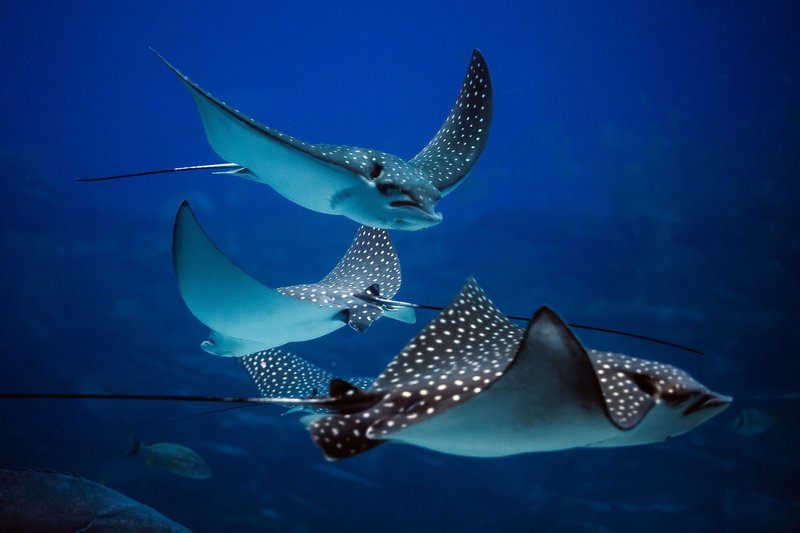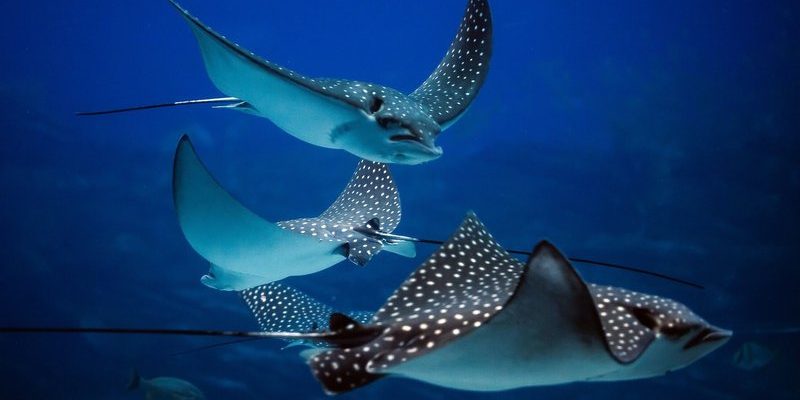
Have you ever seen a stingray glide effortlessly through the water, its flat body moving like a graceful bird in flight? Stingrays are fascinating creatures that belong to the family of cartilaginous fish, which means their skeletons are made of cartilage instead of bone. They can often be found in warm coastal waters around the world, where they bury themselves in the sand, making them easy to overlook. However, these amazing animals are much more than just a pretty sight. Stingrays have unique features and behaviors that make them truly captivating.
Stingrays are famous for their distinct appearance, characterized by a flat, disc-shaped body that can vary significantly in size. Some species can grow as large as a car, while others are tiny enough to fit in the palm of your hand. Their long, whip-like tails can often be mistaken for something other than part of a fish. This tail is actually more than just a prop; it’s equipped with a venomous spine that can inflict a painful sting if provoked. But don’t worry! Stingray attacks on humans are rare and usually only happen when people accidentally step on them. So, let’s dive deeper into the world of stingrays, exploring their habits, habitats, and fascinating lives.
What Are Stingrays?
Stingrays belong to the order Dasyatiformes and are related to sharks, both of which share the same type of flexible skeleton. They are primarily found in shallow coastal waters, although some species inhabit deeper regions of the ocean. With their flattened bodies and large pectoral fins, stingrays have evolved to blend seamlessly with their surroundings, often hiding in the sandy sea floor. When you see one, you might think it’s just part of the underwater landscape!
Their diet mainly consists of small fish, crustaceans, and mollusks, making them opportunistic feeders. Using their electroreception abilities, stingrays can detect the electric fields produced by their prey, allowing them to hunt effectively even in murky waters. They have a unique feeding method: they often bury themselves in sand and wait for unsuspecting prey to come by. Once they sense movement, they quickly pounce, surprising their lunch!
Physical Characteristics
One of the most striking features of stingrays is their flattened, disc-like body. This shape helps them navigate through the water effortlessly, as their large pectoral fins act like wings when they swim. Depending on the species, stingrays can vary tremendously in size. For example, the Southern stingray typically grows to about 4.5 feet across, while the giant manta ray can reach up to 23 feet wide!
Another essential aspect of their anatomy is their tail, which can be quite lengthy, sometimes longer than their bodies themselves. This tail is equipped with one or more venomous spines. While it’s primarily a defense mechanism, the stingray will only use it if threatened. Surprisingly, many species are known to be relatively docile and will often swim away if they sense a human presence.
Habitat and Distribution
Stingrays are adaptable creatures that can thrive in various marine environments. You can typically find them in coastal regions, including sandy beaches and coral reefs. They prefer shallow waters, where they can easily camouflage themselves and hunt for food. Some species, like the Atlantic stingray, are commonly spotted in estuaries and rivers.
Stingrays inhabit warm waters around the globe, but different species have different ranges. For instance, the common stingray can be found in the Atlantic Ocean, while the Pacific stingray is more prevalent in the waters of the Pacific Ocean. Their ability to survive in both saltwater and freshwater settings allows them to migrate to various habitats based on seasonal changes and food availability.
Behavior and Social Structure
Stingrays are generally solitary creatures, although some species may exhibit social behavior by gathering in small groups. During the mating season, males often engage in courtship displays, swimming in circles around females to attract their attention. After mating, females give birth to live young, with the number of pups ranging from a few to several dozen, depending on the species.
When it comes to communication, stingrays primarily rely on body language and scent. Their ability to detect chemical signals in the water helps them find food and sense potential dangers. They also have a keen sense of hearing, which plays a crucial role in their survival.
Diet and Feeding Habits
Stingrays are primarily carnivorous, feeding on a diet of small fish, crustaceans, and mollusks. They use their specialized mouths, located on the underside of their bodies, to suck in their prey. Their flat bodies also help them get close to the ocean floor, where most of their food resides. Watching a stingray hunt is a remarkable sight — they often bury themselves in the sand, with only their eyes peeking above the surface, waiting for fish to swim by.
Once they detect movement, they quickly unearth themselves and use their suction feeding technique to capture their meal. Interestingly, some stingrays also employ a unique method of crushing their prey: their specialized teeth are designed to break through hard shells, making it easier to access the meat inside. This adaptability in their feeding habits allows them to thrive in various environments.
Threats and Conservation Status
Despite their impressive abilities and adaptations, stingrays face several threats in the wild. Habitat loss due to coastal development, pollution, and climate change are significant concerns for their populations. Overfishing, particularly in some regions, also puts additional pressure on both stingrays and their prey, affecting their natural habitats.
Fortunately, many organizations and governments work to protect stingray populations through conservation efforts. Establishing marine protected areas is one way to help safeguard their habitats, allowing them to thrive without the threat of human interference. Additionally, educational programs raise awareness about the importance of preserving these magnificent creatures and their ecosystems.
Interesting Facts About Stingrays
| Size: | Varies from a few inches to over 23 feet |
| Habitat: | Shallow coastal waters, estuaries, and sometimes rivers |
| Diet: | Small fish, crustaceans, mollusks |
| Lifespan: | Typically 15 to 25 years, depending on the species |
| Reproduction: | Viviparous; females give birth to live young |
| Defensive Mechanism: | Venomous spine on their tail |
Keeping Stingrays in Aquariums
Many aquarium enthusiasts find stingrays fascinating and consider them for their home tanks. However, caring for stingrays requires specific knowledge and conditions. Firstly, the tank must be large enough to accommodate their size, as many species grow considerably. Keeping them in an appropriate environment helps mimic their natural habitat, allowing them to thrive in captivity.
Water quality is critical for stingrays. A stable temperature and salinity level are essential for their health. Additionally, providing plenty of hiding spots, like rocks or sand, is important since stingrays like to bury themselves for comfort. Lastly, providing a varied diet that includes live and frozen food is vital for their overall well-being.
Stingray Conservation Efforts
As awareness of the challenges facing stingray populations grows, conservation efforts have become increasingly vital. Many organizations focus on habitat protection, as healthy ecosystems are crucial for sustaining stingray populations. This includes working to minimize pollution and preventing overfishing in their habitats.
Additionally, educational initiatives aim to inform the public about the significance of stingrays and their roles in marine ecosystems. By highlighting their importance and the threats they face, these programs encourage responsible behavior towards marine life, fostering a sense of stewardship among beachgoers, scuba divers, and fishing communities.
FAQ
Are stingrays dangerous to humans?
Stingrays usually aren’t dangerous, and attacks on humans are quite rare. They’re more likely to swim away than confront a person. However, they do have a venomous spine that can cause painful injuries if stepped on or provoked. It’s wise to shuffle your feet when walking in shallow waters where stingrays might be hiding.
How do stingrays reproduce?
Most stingrays are viviparous, meaning they give birth to live young rather than laying eggs. After a gestation period that can range from 5 to 12 months, depending on the species, a female stingray gives birth to several pups at once. The young stingrays resemble miniature adults and are often independent from birth.
What do stingrays eat?
Stingrays primarily feed on small fish, crustaceans, and mollusks. They are excellent hunters and use their sensory abilities to detect prey hiding in the sand. Their unique mouths allow them to suck in food effectively, making them skilled at capturing their meals.
How can I tell different stingray species apart?
There are over 200 species of stingrays, each with unique characteristics. Differences can include body shape, color patterns, and the size of the tail. Researching specific species can help you identify them more easily, and visiting aquariums can offer a closer look at their diversity.
Can stingrays survive in freshwater?
Yes, some stingray species, like the freshwater stingray, are well-adapted to live in rivers and lakes. They can regulate their salt concentration, allowing them to thrive in both saltwater and freshwater environments. Others primarily inhabit coastal areas but may venture into estuaries and brackish waters.
What is the largest species of stingray?
The giant manta ray holds the title for the largest stingray species, measuring up to 23 feet across! These gentle giants primarily feed on plankton and are known for their impressive acrobatics, often breaching the water’s surface gracefully.
How can I help conserve stingrays?
Supporting conservation efforts is a great way to help stingrays. You can participate in beach clean-ups, reduce plastic use, and support marine protected areas. Additionally, educating yourself and others about stingrays can raise awareness and promote responsible behavior around their habitats.
Do stingrays have any predators?
Yes, stingrays have a few natural predators, including sharks, larger fish, and some marine mammals. While their flat bodies help them camouflage against the ocean floor, they’re still vulnerable to being predated on, especially when young.

